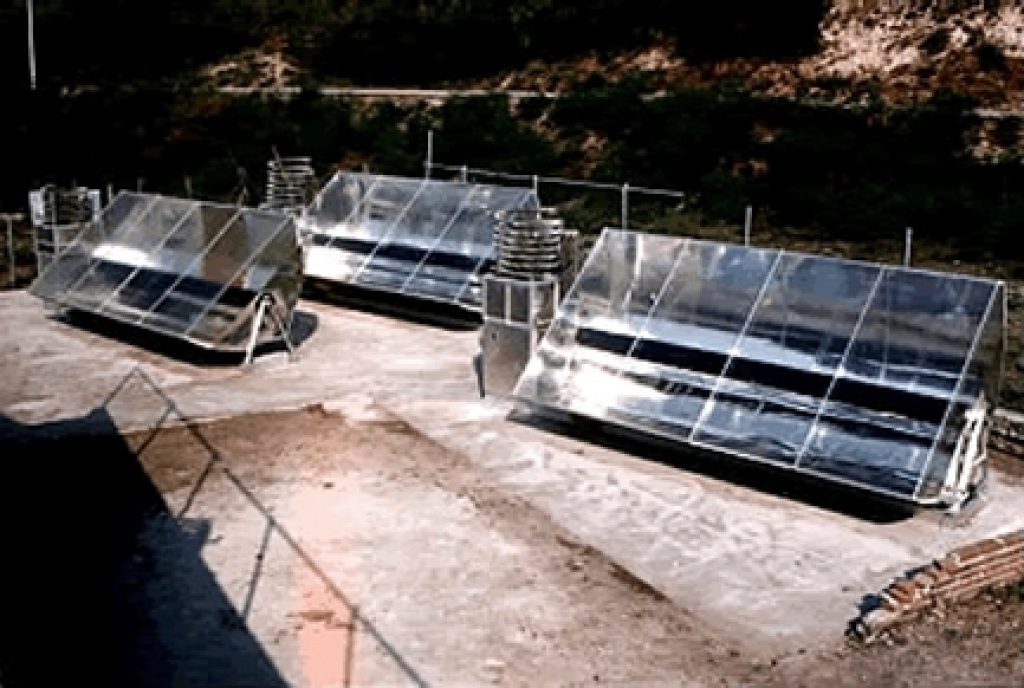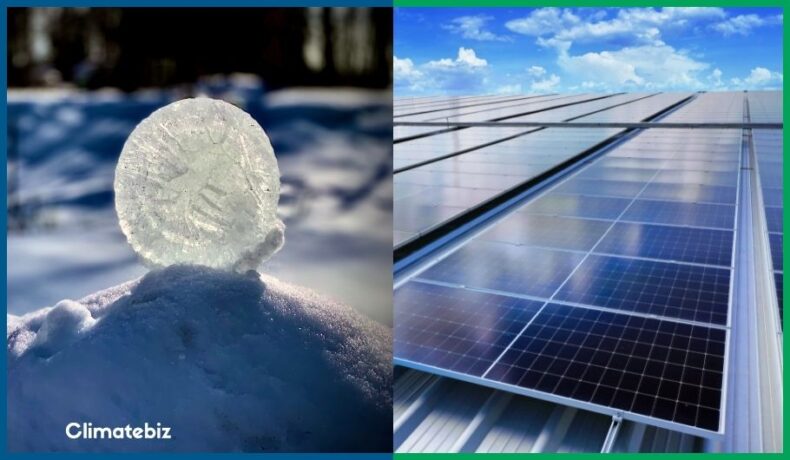There’s probably not a person alive that doesn’t enjoy indulging in a crisp, ice-cold beverage, especially on a summer holiday away from the city. The only problem — no electricity equals no ice. Well, thankfully, solar has again come to the rescue, allowing you to make your own solar ice, even in the most remote locations!
With an average consumption of 400 pounds of ice per year (116 glasses per month), it’s no secret that Americans enjoy having their favorite drinks “on the rocks.”
However, making ice requires energy, an average of 0.1kWh/lbs, to be precise. As such, the process requires a connection to the utility grid.
Well, it did until solar ice production rolled around.
In this article, we teach you how to set up your own solar ice system. You’ll discover the required parts, the costs involved, and more!
Table of Contents
What Is Solar Ice?
Solar ice is made using solar energy, meaning the process does not require electricity from a grid-tied connection. Ultimately, this allows ice production while living off-grid or during a remote holiday trip.
Let’s look at the components you’ll require and the costs involved.
How To Make Ice With Solar Power?
In this section, you learn how to make ice for domestic production.
DIY Solar Ice With An Inverter For A Camping Trip / Off-Grid Cabin
You’ll require the following materials:
| Material | Price | Product Link |
|---|---|---|
| 2 x 12V Solar panels 100W | $192 | View on Amazon |
| Solar charge controller | $30.99 | View on Amazon |
| Solar battery, 12V, 50Ah, 600Wh | $269.99 | View on Amazon |
| Inverter – 1000W | $89.97 | View on Amazon |
| Ice cube machine -100W | $112.9 | View on Amazon |
| Total cost: $695.85 |
Your goal here is to build a mini off-grid system in which the solar charge controller charges the battery with solar energy. The inverter feeds on the battery and converts DC into AC which the ice cube machine uses.

This setup will cost you almost $700 and produce a maximum of 10lbs and 9 ice cubes every 8 minutes.
Yes, the cost is steep but let’s compare it with commercial ice cube bags:
On average, a 10lbs bag costs $2 (can be as high as $4); that’s 0.2$/lb. Therefore a family of 4 using 1.5lbs of ice per day per person will use 6lbs per day (1.2$/day).
With the above in mind, your estimated payback period would be 1 and a half years. Not bad, right?
If you still think it’s not worth the investment, be aware that you can use your solar setup to power other small appliances like a TV, laptop, or speakers.
Furthermore, you can produce solar ice without an inverter for a more efficient and compact design. Let’s see how:
How To Make Solar Ice Without An Inverter?
Inverters convert DC (Direct Current) electricity from the solar panels and battery into AC (Alternating Current) usable by your appliances, including the ice cube machine.
Each electricity conversion step reduces the overall efficiency of the system.
For example, the inverter is 90% efficient. In other words, if you’d like to power your 100W ice cube machine, you’ll need to input 110W into the inverter to compensate for the conversion loss.
Recently, with solar energy development, DC appliances are becoming more available. This is great news as these appliances don’t require an inverter, making them more energy efficient than their AC counterparts.
In fact, our recent solar water pumping article shows that a DC water pump can pump twice as much water as an AC pump of the same wattage.
The above also applies to cooling — DC ice cube machines are 70% more efficient than their AC counterparts. Consequently, you’ll need fewer solar panels and a smaller battery to produce the same quantity of ice.
Only a few DC ice cube machines are available, such as the Snomaster Icemaker, the Brass Monkey 12V ice cube maker, and the Challenger Portable Ice maker.

Those machines are rather pricey. They cost anywhere from $280 to $900.
DC Solar Ice Production: Cost Estimation
Let’s take, for example, the BrassMonkey ($280); it can produce up to 26lbs per day and only draws 60W(DC).
You could power it with only one 100W solar panel and a 12V, 25Ah battery. With this setup, you’ll get around 10lbs of ice cube per day.
The estimated total cost for this setup will be $607.
This is cheaper than the AC ice system introduced earlier.
However, the main drawback is that the BrassMonkey is currently unavailable in the U.S.
So far, the only DC ice cube model we found for U.S. customers is the more powerful and expensive ($900) Snomaster model.
How To Produce Solar Ice With No Solar Panels: Thermal Solar Ice
As surprising as it sounds, producing a large quantity of ice with solar energy without electricity, solar panels, or fuel is possible. How? By using solar thermal!
In a thermal solar ice system such as the ISAAC solar ice maker, refrigeration is based on a vapor absorption refrigeration system: the Ammonia-water system. Ammonia is the refrigerant, and water is the absorbent.

For more details about the ammonia-water refrigeration system, we recommend this article.
With the ISAAC solar ice maker, the daily production can reach 1lb/sqft of solar collector. The cost of a single unit is $7,000 for 118sqft.
A rapid calculation shows that one unit can produce up to 118lbs of ice daily.
This system is ideally suited for remote communities and has already impacted the lives of many farmers in Kenya.
How Many Solar Panels Do You Need To Make Solar Ice?
The answer here depends on the amount of ice you require. But here are three scenarios:
- To produce 10lbs of ice per day at home, you’ll need 2 solar panels of 100W.
- A solar ice commercial production (for a restaurant/bar/hotel) of 250lbs/day requires 6 solar panels of 500W each.
- An industrial ice machine that produces 2200lbs of ice a day requires 25 solar panels of 500W each.
Let’s see how we get to these figures:
Number Of Solar Panels Required For Ice Production At Home
Firstly, recall that your solar energy production strongly depends on the solar irradiation at your location.
For our example, we consider a system installed in California where the solar potential for a 1kW solar system is 4.9kWh per day.
The power of a domestic ice cube machine is around 100W. If this machine works continuously for a day, it will produce 26lbs of ice cubes and consume:
24h x 100W =2400 Wh or 2.4 kWh
Consequently, to produce 10lbs, it needs 0.92kWh.
On the other hand, two 100W solar panels (total 200W) produce 0.98kWh a day.
In conclusion, 2 x 100W solar panels will cover 100% of the energy needs for solar ice.
Number Of Solar Panels Required For Ice Production At A Restaurant/Bar/Hotel
Bar and restaurants need a lot of ice daily — on average, 2lbs per customer.
Let’s consider a daily production of 250lbs.
Based on the specification of the Prodigy Plus C0322 ice cube machine, it needs around 15 kWh for 250lbs a day.
With the solar production potential of California, it would need a solar system of 3kW or a total of 6 x 500W solar panels.
Number Of Solar Panels Required For Large Scale Ice Production (2200lbs+)
On a larger (commercial) scale, ice is produced by the ton (2200lbs) and is used for food preservation.
The most efficient industrial machine produces 2200lbs of ice daily and consumes 60kWh.
A 12.25kW solar system can produce 60 kWh of solar electricity per day. That is equivalent to 25 x 500W.
Benefits Of Solar Ice
- Solar ice benefits off-grid enthusiasts.
- This form of ice production is perfect for those who own an RV, boat, or people who often go on camping trips. You can produce a decent quantity of ice cubes (+10lbs per day) anywhere without connecting to the utility grid.
- You’ll reduce your carbon footprint thanks to clean solar energy.
- A restaurant or a bar could reduce their energy bills, especially in states with high electricity costs, such as California or Hawaii.
- Remote communities would get the most benefits out of solar ice for food preservation. They often don’t have access to a utility connection and rely on costly fuel generators.
- Producing ice with renewable energy increases the incomes of local farmers and fishermen, reducing poverty and contributing to food security.
Final Thoughts
Solar ice is the way to go in any off-grid situation: a camping trip or on your boat or RV.
You’ll get a substantial quantity of ice thanks to the electricity generated by your panels and the backup battery for continuous production.
But remember: this method of ice production is scalable. Below we have summarized the number of panels required to produce ice, from residential to industrial scale:
| Production per day | Energy consumption | Number of solar panels | |
|---|---|---|---|
| Domestic ice cube machine | 10lbs | 0.1kWh/lbs | 2*100W |
| Professional ice cube machine | 250lbs | 0.06kWh/lbs | 6*500W |
| Industrial ice production | 2200lbs | 0.028kWh/lbs | 25*500W |
Finally, solar ice is an excellent help for remote communities with no access to grid electricity. It is a way to boost the local production of fresh food and increase the livelihood of thousands.

